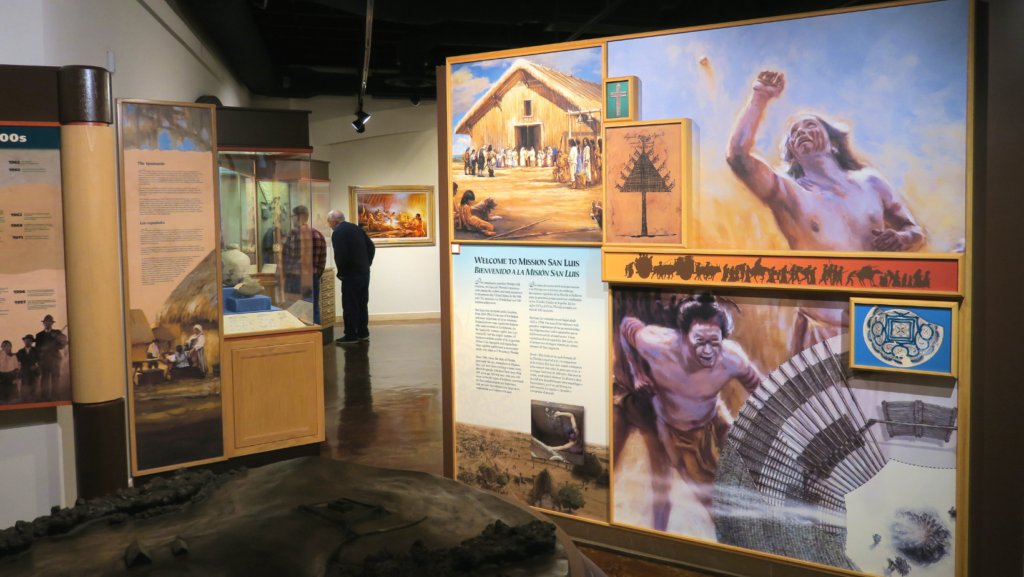
Museum exhibits at Mission San Luis in Tallahassee, Florida
Almost 12,000 years ago, people inhabited this area. They established settlements, created some of the finest Native American pottery ever made, and traded with places as far away as the Great Lakes.
During the early part of what is known as the Fort Walton period, from 1000AD to 1575 AD, the Lake Jackson mounds were created, which served as the political and ceremonial center for a large village, surrounding satellite villages, and single-family farmsteads. Later in the period, the area between Aucilla and Ochlockonee Rivers supported a population of 30,000 people ruled by a chief who lived in the village of Anhayca, approximately a mile east of today’s Capitol building in Tallahassee.
Europeans first came into contact with the Apalachee Indians of this region in 1528, and over the following years, through battle and disease, the Spanish explorers greatly decimated the native population. By 1607, the Apalachee invited the Spaniards to establish missions. At least some missions were established in Leon County, including the administrative hub at San Luis, the western terminus for the mission chain in North Florida.
This delicate partnership was destroyed by British and Creek Indian raids in 1704, which resulted in the Apalachee and Spaniards abandoning Leon County. Creeks began to resettle in the area, establishing large villages and towns. They too were driven out, this time by Andrew Jackson’s raids in 1818.
On July 10, 1821, possession of Florida officially transferred from Spain to the United States per the Adams-Onis Treaty, ending centuries of rule over Florida by European powers including Spain, Great Britain, and France. Immediately thereafter, the various functions of territorial and local government were established, and the first meeting of the newly established Territorial Council, the precursor of the Florida legislature, was held in June 1822 at Pensacola, the principal city of West Florida.
The following summer, in 1823, the second session of the Council meeting was held in St. Augustine, the principal city of East Florida. Given the difficulties and perils of travel during the 1820s and with some councilmen traveling for upwards of 20 days to the meeting site, the Council decided it should meet at some suitable location midway between these two cities. In the summer of 1823, per the instructions of the Council, the governor appointed two commissioners — one from Pensacola and another from St. Augustine — as official scouts to select a site for the new seat of government. The scouts, Dr. William H. Simmons of Pensacola and John Lee Williams of St. Augustine, rendezvoused at Saint Marks to begin their search. After a month of scouting the vicinity, they agreed on a location near the abandoned Seminole village of Tallahassa Taloofa and close to a small cascade.
On March 4, 1824, Governor DuVal proclaimed the Legislative Council would hold its next meeting at the place called Tallahassee. Soon after, on May 24, 1824, Congress appropriated an entire section of federal land (one square mile) for use as the new seat of government for the Florida Territory, and it instructed the Surveyor General of Florida to commence the surveying of the entire state from this point.
Work commenced in earnest on the construction of temporary quarters for the Legislative Council and the Council conducted its first meeting at Tallahassee on November 8, 1824. As part of their session, the Council officially created Leon County on December 29, 1824, from a portion of Gadsden County. During its next annual session, on December 9, 1825, the Council issued the first City Charter to the City of Tallahassee. Less than one month later, the city’s first municipal elections were held and a mayor and city council were elected.
A survey of the city was soon completed and town lots were sold at auction, raising money for public improvements in the town and capital complex. Between this time and Statehood in 1845, Tallahassee and Leon County’s population grew rapidly and the area would become the major economic hub of Middle Florida. Between 1824 and Statehood in 1845, Tallahassee would see the first railroad in Florida chartered – the St. Marks Railroad (1835), the Second Seminole War (1836-1842), a devastating yellow fever epidemic (1841), and the Great Fire (1843) that burned most of the town but miraculously spared the Capitol. On March 3, 1845, Florida was admitted to the Union and became America’s 27th state.
Courtesy of the Tallahassee Trust for Historic Preservation and Matt Lutz, Director of Records Management, City of Tallahassee.
